The Early Neoproterozoic Andean-Type Orogenic and Within-Plate Magmatic Events in the Northern Margin of the Yangtze Craton during the Convergence of the Rodinia Supercontinent
Abstract
1. Introduction
2. Geological Setting and Petrological Characteristics
2.1. Sandouping Tonalite
2.2. Luxiping Trondhjemite
2.3. Yingzizui Granodiorite
2.4. Maopingtuo Oligoporphyritic Granodiorite
2.5. Neikou Porphyric Granodiorite
2.6. Granodiorite Dyke
3. Analytical Methods
3.1. LA-ICP-MS Zircon U–Pb Dating
3.2. SHRIMP Zircon U–Pb Dating
3.3. Whole-Rock Geochemical Analyses
3.4. Zircon Hf Isotopic Analyses
3.5. Sr-Nd Isotopic Composition Analyses
4. Results
4.1. Zircon U-Pb Dating
4.1.1. Sandouping Tonalite
4.1.2. Luxiping Trondhjemite
4.1.3. Yingzizui Granodiorite
4.1.4. Maopingtuo Oligoporphyritic Granodiorite
4.1.5. Neikou Porphyric Granodiorite
4.1.6. Granodiorite Dyke
4.2. Geochemistry
4.2.1. Major Elements
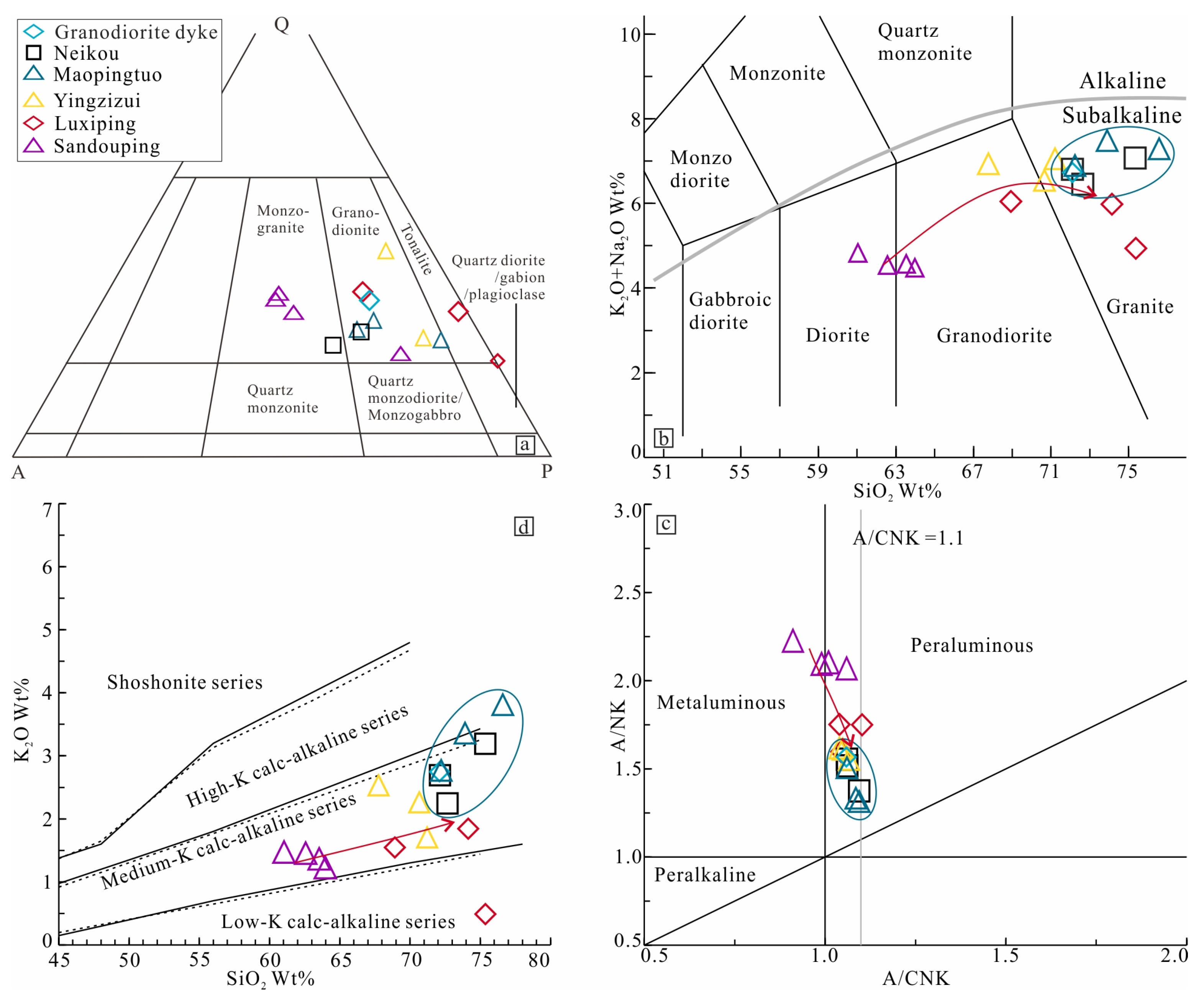
4.2.2. Rare Earth Elements
4.2.3. Trace Elements
4.3. Zircon Lu-Hf Isotopes
4.4. Whole-Rock Sr-Nd Isotopes
5. Discussion
5.1. Two-Stage Petrogenesis of the HGC
5.2. Magmatic Source and Evolution of the HGC
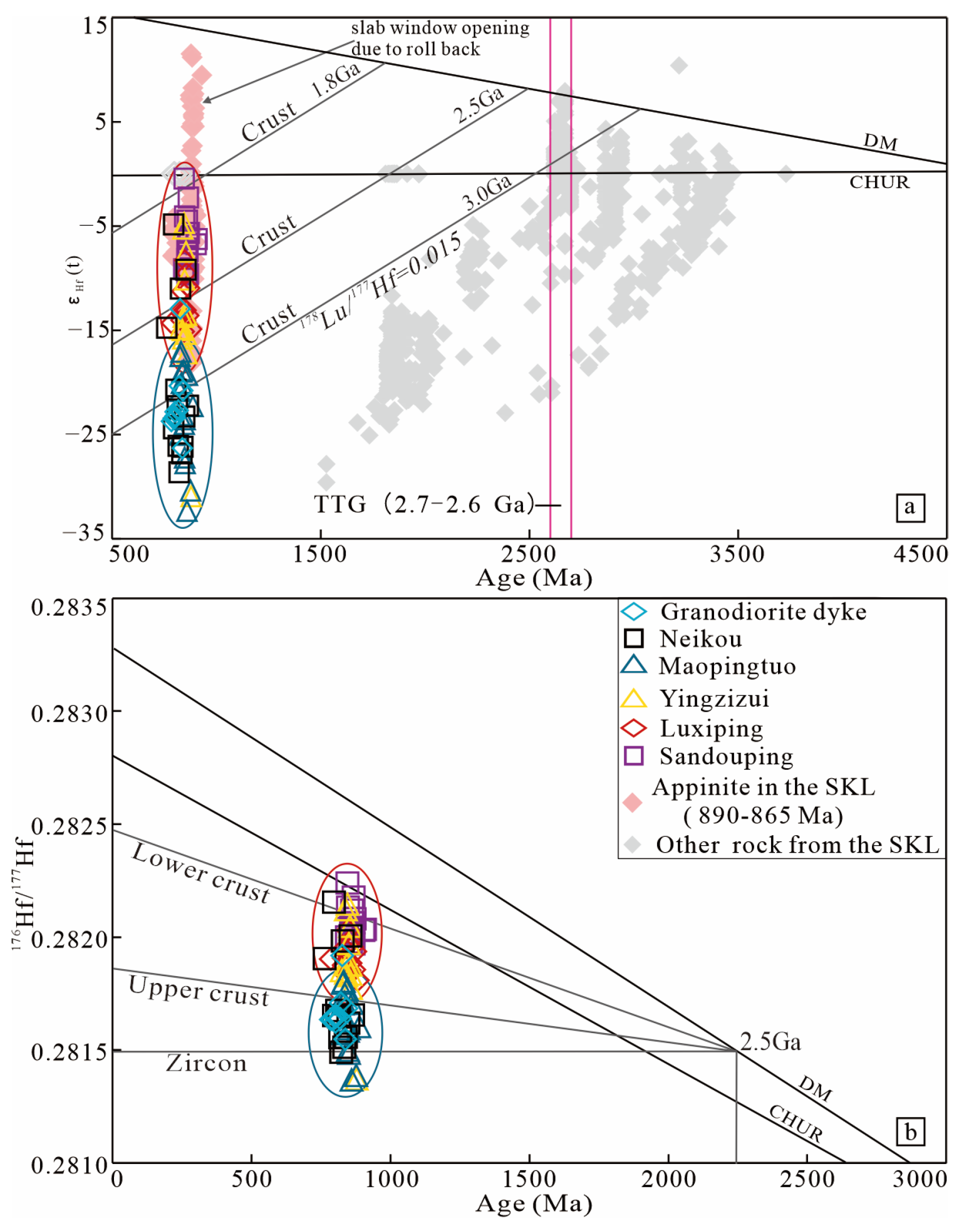
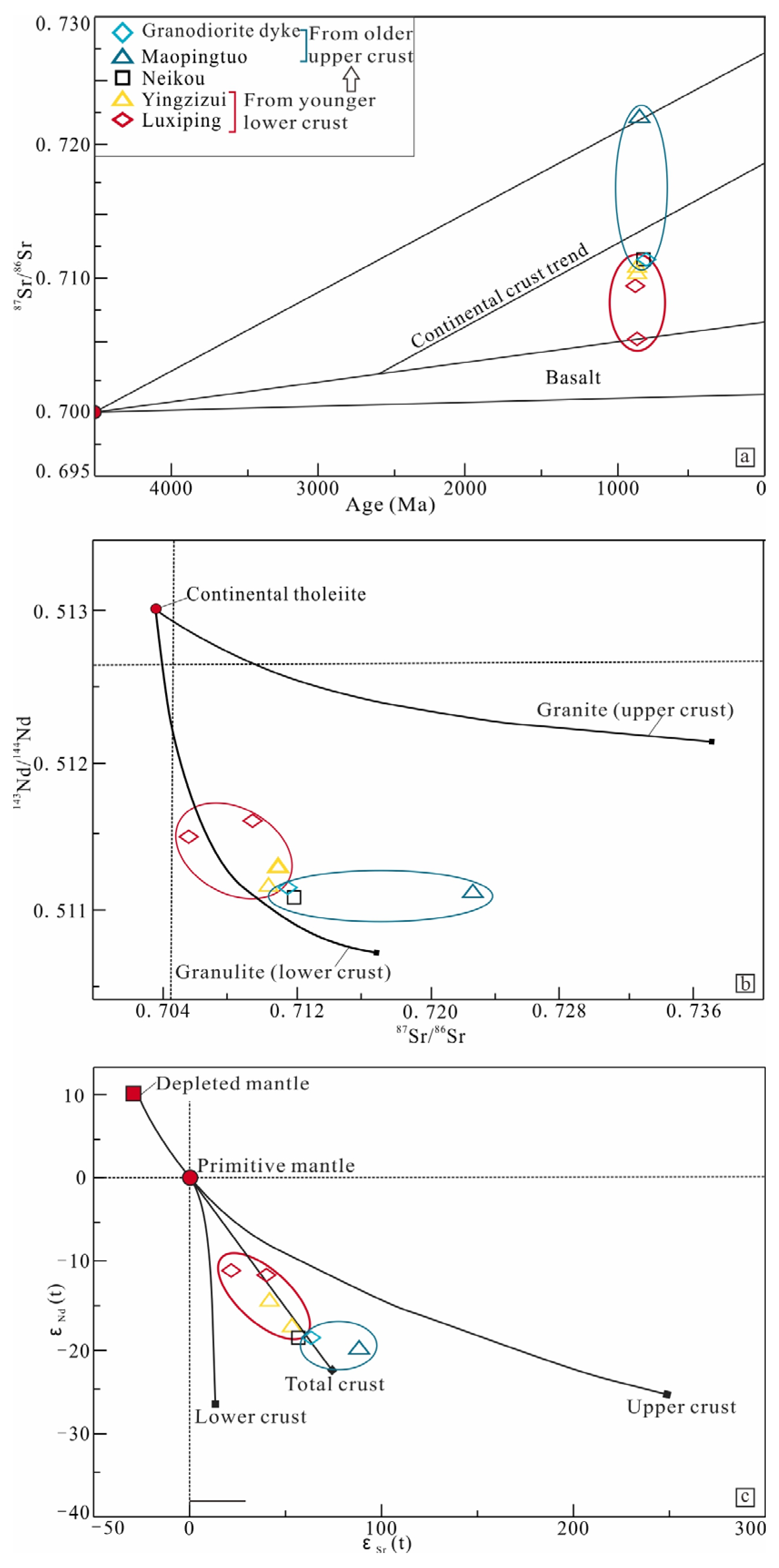
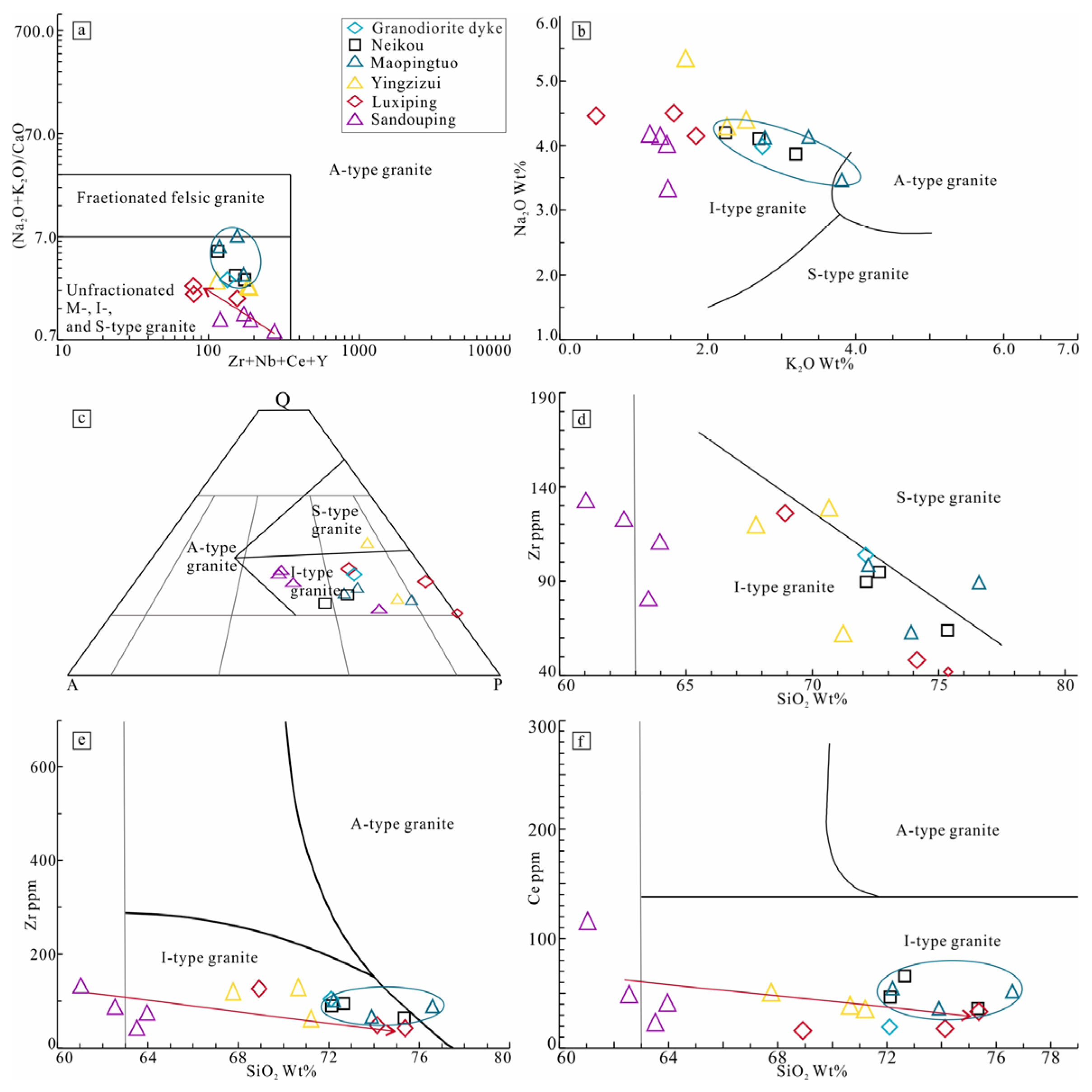
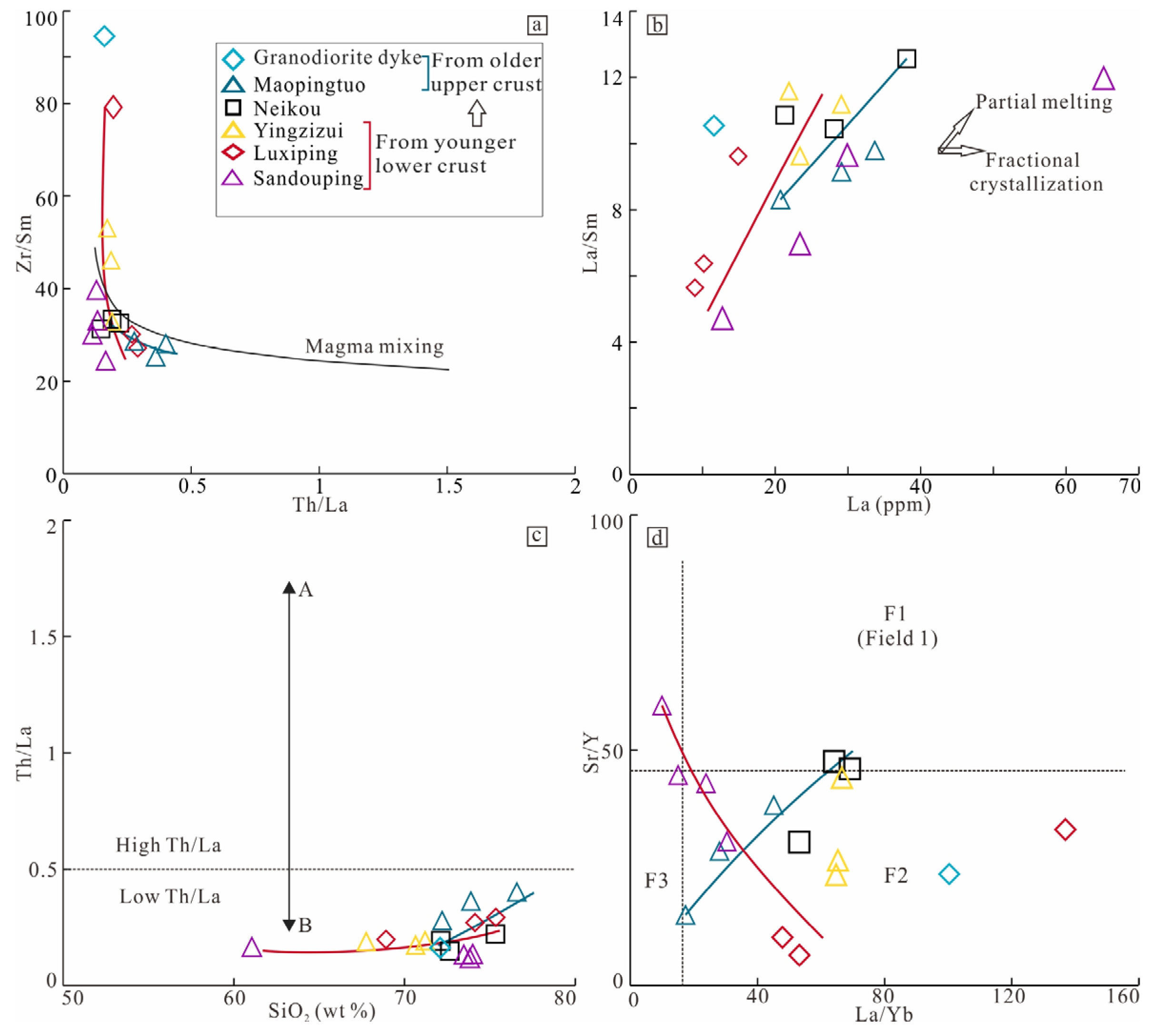
5.3. Petrogenetic Setting of the HGC
5.4. Tectonic Importance
6. Conclusions
Supplementary Materials
Author Contributions
Funding
Data Availability Statement
Acknowledgments
Conflicts of Interest
References
- Cawood, P.A.; Wang, W.; Zhao, T.Y.; Xu, Y.J.; Mulder, J.A.; Pisarevsky, S.A.; Zhang, L.M.; Gan, C.S.; He, H.Y.; Liu, H.C.; et al. Deconstructing South China and consequences for reconstructing Nuna and Rodinia. Earth Sci. Rev. 2020, 204, 24. [Google Scholar] [CrossRef]
- Cawood, P.A.; Wang, Y.J.; Xu, Y.J.; Zhao, G.C. Locating South China in Rodinia and Gondwana: A fragment of greater India lithosphere? Geology 2013, 41, 903–906. [Google Scholar] [CrossRef]
- Cawood, P.A.; Zhao, G.C.; Yao, J.L.; Wang, W.; Xu, Y.J.; Wang, Y.J. Reconstructing South China in Phanerozoic and Precambrian supercontinents. Earth Sci. Rev. 2018, 186, 173–194. [Google Scholar] [CrossRef]
- Li, Z.X.; Bogdanova, S.V.; Collins, A.S.; Davidson, A.; De Waele, B.; Ernst, R.E.; Fitzsimons, I.C.W.; Fuck, R.A.; Gladkochub, D.P.; Jacobs, J.; et al. Assembly, configuration, and break-up history of Rodinia: A synthesis. Precambrian Res. 2008, 160, 179–210. [Google Scholar] [CrossRef]
- Li, Z.X.; Li, X.H.; Li, W.X.; Ding, S.J. Was Cathaysia part of Proterozoic Laurentia? new data from Hainan Island, South China. Terr. Nova 2008, 20, 154–164. [Google Scholar] [CrossRef]
- Li, Z.x.; Li, X.h.; Zhou, H.w.; Kinny, P.D. Grenvillian continental collision in south China: New SHRIMP U-Pb zircon results and implications for the configuration of Rodinia. Geology 2002, 30, 163–166. [Google Scholar] [CrossRef]
- Shu, L.S. An analysis of principal features of tectonic evolution in South China Block. Geol. Bull. China 2012, 31, 1035–1053. [Google Scholar]
- Shu, L.S.; Wang, J.Q.; Yao, J.L. Tectonic evolution of the eastern Jiangnan region, South China: New findings and implications on the assembly of the Rodinia supercontinent. Precambrian Res. 2019, 322, 42–65. [Google Scholar] [CrossRef]
- Shu, L.S.; Yao, J.L.; Wang, B.; Faure, M.; Charvet, J.; Chen, Y. Neoproterozoic plate tectonic process and Phanerozoic geodynamic evolution of the South China Block. Earth Sci. Rev. 2021, 216, 30. [Google Scholar] [CrossRef]
- Zhao, G.C.; Cawood, P.A. Tectonothermal evolution of the Mayuan assemblage in the Cathaysia Block: Implications for neoproterozoic collision-related assembly of the South China craton. Am. J. Sci. 1999, 299, 309–339. [Google Scholar] [CrossRef]
- Zhao, G.C.; Cawood, P.A. Precambrian geology of China. Precambrian Res. 2012, 222, 13–54. [Google Scholar] [CrossRef]
- Zhao, J.H.; Zhang, S.B.; Wang, X.L. Neoproterozoic geology and reconstruction of South China. Precambrian Res. 2018, 309, 1–5. [Google Scholar] [CrossRef]
- Johansson, A.; Bingen, B.; Huhma, H.; Waight, T.; Vestergaard, R.; Soesoo, A.; Skridlaite, G.; Krzeminska, E.; Shumlyanskyy, L.; Holland, M.E. A geochronological review of magmatism along the external margin of Columbia and in the Grenville-age orogens forming the core of Rodinia. Precambrian Res. 2022, 371, 106463. [Google Scholar] [CrossRef]
- Wang, W.; Cawood, P.A.; Pandit, M.K.; Xia, X.P.; Raveggi, M.; Zhao, J.H.; Zheng, J.P.; Qi, L. Fragmentation of South China from greater India during the Rodinia-Gondwana transition. Geology 2021, 49, 228–232. [Google Scholar] [CrossRef]
- Wu, P.; Zhang, S.B.; Zheng, Y.F.; Fu, B.; Liang, T. Amalgamation of South China into Rodinia during the Grenvillian accretionary orogeny: Geochemical evidence from Early Neoproterozoic igneous rocks in the northern margin of the South China Block. Precambrian Res. 2019, 321, 221–243. [Google Scholar] [CrossRef]
- Zhou, Z.Y.; Yang, J.X.; Zhou, H.W.; Jiang, L.S. Significance on Hubei Huangling complex in the Rodinia super continent of evolution. Resour. Environ. Eng. 2007, 21, 380–384. [Google Scholar]
- Zhao, J.H.; Li, Q.W.; Liu, H.; Wang, W. Neoproterozoic magmatism in the western and northern margins of the Yangtze Block (South China) controlled by slab subduction and subduction-transform-edge-propagator. Earth Sci. Rev. 2018, 187, 1–18. [Google Scholar] [CrossRef]
- Deng, H.; Kusky, T.M.; Wang, L.; Peng, S.B.; Jiang, X.F.; Wang, J.P.; Wang, S.J. Discovery of a sheeted dike complex in the northern Yangtze craton and its implications for craton evolution. J. Earth Sci. 2012, 23, 676–695. [Google Scholar] [CrossRef]
- Deng, H.; Peng, S.B.; Polat, A.; Timothy, M.K.; Jiang, X.F.; Han, Q.S.; Wang, L.; Huang, Y.; Wang, J.P.; Zeng, W.; et al. Neoproterozoic IAT intrusion into Mesoproterozoic MOR Miaowan Ophiolite, Yangtze Craton: Evidence for evolving tectonic settings. Precambrian Res. 2017, 289, 75–94. [Google Scholar] [CrossRef]
- Jiang, X.F.; Peng, S.B.; Han, Q.S. Petrogenesis and Geological Significance of ca. 860 Ma Dikes in Southern Huangling Anticline, Yangtze Craton. Earth Sci. 2021, 46, 2117–2132. [Google Scholar]
- Jiang, X.f.; Peng, S.B.; Kusky, T.M.; Wang, L.; Deng, H. Petrogenesis and Geotectonic Significance of Early-Neoproterzoic Olivine-Gabbro within the Yangtze Craton: Constrains from the Mineral Composition, U-Pb Age and Hf Isotopes of Zircons. J. Earth Sci. 2018, 29, 93–102. [Google Scholar] [CrossRef]
- Peng, M.; Wu, Y.B.; Gao, S.; Zhang, H.f.; Wang, J.; Liu, X.C.; Gong, H.J.; Zhou, L.; Hu, Z.C.; Liu, Y.S.; et al. Geochemistry, zircon U–Pb age and Hf isotope compositions of Paleoproterozoic aluminous A-type granites from the Kongling terrain, Yangtze Block: Constraints on petrogenesis and geologic implications. Gondwana Res. 2012, 22, 140–151. [Google Scholar] [CrossRef]
- Peng, S.B.; Kusky, T.M.; Jiang, X.F.; Wang, L.; Wang, J.P.; Deng, H. Geology, geochemistry, and geochronology of the Miaowan ophiolite, Yangtze craton: Implications for South China’s amalgamation history with the Rodinian supercontinent. Gondwana Res. 2012, 21, 577–594. [Google Scholar] [CrossRef]
- Cui, X.; Zhu, W.B.; Wang, X. Neoproterozoic modification of heterogeneous continental lithosphere beneath the Yangtze interior: Revealed from mafic dykes from the Huangling area, South China. Int. J. Earth Sci. (Geol. Rundsch.) 2021, 111, 27–51. [Google Scholar] [CrossRef]
- Wei, Y.X.; Peng, S.B.; Jiang, X.F.; Peng, Z.Q.; Peng, L.H.; Li, Z.H.; Zhou, P.; Zeng, X.W. SHRIMP zircon U-Pb ages and geochemical characteristics of the neoproterozoic granitoids in the Huangling anticline and its tectonic setting. J. Earth Sci. 2012, 23, 659–676. [Google Scholar] [CrossRef]
- Zhao, J.H.; Zhou, M.F.; Zheng, J.P. Neoproterozoic high-K granites produced by melting of newly formed mafic crust in the Huangling region, South China. Precambrian Res. 2013, 233, 93–107. [Google Scholar] [CrossRef]
- Zhao, J.H.; Zhou, M.F.; Zheng, J.P.; Griffin, W.L. Neoproterozoic tonalite and trondhjemite in the Huangling complex, South China: Crustal growth and reworking in a continental arc environment. Am. J. Sci. 2013, 313, 540–583. [Google Scholar] [CrossRef]
- Zhang, Q.; Wang, Y.L.; Jin, W.J.; Jia, X.Q.; Li, C.D. Criteria for the recognition of pre-, syn-and post-orogenic granitic rocks. Geolocial Bull. China 2008, 27, 1–18. [Google Scholar]
- Pearce, J.A.; Peate, D.W. Tectonic implications of the composition of volcanic arc magmas. Annu. Rev. Earth Planet. Sci. 1995, 23, 251–285. [Google Scholar] [CrossRef]
- Chappell, B.W.; White, A.J.R. I-Type and S-Type Granites in the Lachlan Fold Belt. Trans. R. Soc. Edinb.-Earth Sci. 1992, 83, 1–26. [Google Scholar]
- Whalen, J.B.; Currie, K.L.; Chappell, B.W. A-type granites: Geochemical characteristics, discrimination and petrogenesis. Contrib. Mineral. Petrol. 1987, 95, 407–419. [Google Scholar] [CrossRef]
- Pearce, J.A. Sources and settings of granitic rocks. Int. Union Geol. Sci. 1996, 19, 120–125. [Google Scholar] [CrossRef]
- Sylvester, P.J. Post-Collisional Alkaline Granites. J. Geol. 1989, 97, 261–280. [Google Scholar] [CrossRef]
- Carvalho, P.C.S.; Neiva, A.M.R.; Silva, M.M.V.G.; Corfu, F. A unique sequential melting mechanism for the generation of anatectic granitic rocks from the Penafiel area, northern Portugal. Lithos 2012, 155, 110–124. [Google Scholar] [CrossRef]
- Gao, S.; Ling, W.L.; Qiu, Y.M.; Lian, Z.; Gerald, H.; Klaus, S. Contrasting geochemical and Sm-Nd isotopic compositions of Archean metasediments from the Kongling high-grade terrain of the Yangtze craton evidence for cratonic evolution and redistribution of REE during crustal anatexis. Geochim. Cosmochim. Acta 1999, 63, 2071–2088. [Google Scholar] [CrossRef]
- Gao, S.; Yang, J.; Zhou, L.; Li, M.; Hu, Z.C.; Guo, J.L.; Yuan, H.L.; Gong, H.J.; Xiao, G.Q.; Wei, J.Q. Age and growth of the Archean Kongling terrain, South China, with emphasis on 3.3 ga granitoid gneisses. Am. J. Sci. 2011, 311, 153–182. [Google Scholar] [CrossRef]
- Guo, J.L.; Gao, S.; Wu, Y.B.; Li, M.; Chen, K.; Hu, Z.C.; Liang, Z.W.; Liu, Y.S.; Zhou, L.; Zong, K.Q.; et al. 3.45Ga granitic gneisses from the Yangtze Craton, South China: Implications for Early Archean crustal growth. Precambrian Res. 2014, 242, 82–95. [Google Scholar] [CrossRef]
- Ling, W.; Gao, S.; Cheng, J.; Jiang, L.; Yuan, H.; Hu, Z. Neoproterozoic magmatic events within the Yangtze continental interior and along its northern margin and their tectonic implication: Constraint from the ELA-ICPMS U-Pb geochronogy of zicrons from the Huangling and Hannan complexes. Acta Petrol. Sin. 2006, 22, 387–396. [Google Scholar]
- Li, H.Q.; Zhou, W.X.; Wei, Y.X.; Chang, F.; Wang, B.; Tan, M.T.; Hu, Z.X.; Xu, D.L.; Liu, H. Two extensional events in the early evolution of the Yangtze Block, South China: Geochemical and isotopic evidence from two sets of Paleoproterozoic alkali porphyry in the Northern Kongling terrane. Geol. J. 2020, 55, 6296–6324. [Google Scholar] [CrossRef]
- Zhou, H.; Zhou, W.X.; Wei, Y.X.; Fru, E.C.; Huang, B.; Fu, D.; Li, H.Q.; Tan, M.T. Mesoarchean banded iron-formation from the northern Yangtze Craton, South China and its geological and paleoenvironmental implications. Precambrian Res. 2022, 383, 106905. [Google Scholar] [CrossRef]
- Zhou, W.X.; Huang, B.; Wei, Y.X.; Li, H.Q.; Tan, M.T.; Fu, D. Paleoproterozoic ophiolitic melanges and orogenesis in the northern Yangtze Craton: Evidence for the operation of modern-style plate tectonics. Precambrian Res. 2021, 364, 106385. [Google Scholar] [CrossRef]
- Han, Q.S.; Peng, S.B. Paleoproterozoic subduction within the Yangtze Craton: Constraints from Nb-enriched mafic dikes in the Kongling complex. Precambrian Res. 2020, 340, 105634. [Google Scholar] [CrossRef]
- Han, Q.S.; Peng, S.B.; Kusky, T.; Polat, A.; Jiang, X.F.; Cen, Y.; Liu, S.F.; Deng, H. A Paleoproterozoic ophiolitic melange, Yangtze craton, South China: Evidence for Paleoproterozoic suturing and microcontinent amalgamation. Precambrian Res. 2017, 293, 13–38. [Google Scholar] [CrossRef]
- Han, Q.S.; Peng, S.B.; Polat, A.; Kusky, T. Petrogenesis and geochronology of Paleoproterozoic magmatic rocks in the Kongling complex: Evidence for a collisional orogenic event in the Yangtze craton. Lithos 2019, 342, 513–529. [Google Scholar] [CrossRef]
- Wei, J.Q. Petrology and geochemistry of the Archean Huangling greenstone belt in the Yangtze Craton, South China. Precambrian Res. 2021, 364, 106340. [Google Scholar] [CrossRef]
- Wei, J.Q.; Wei, Y.X.; Wang, J.X.; Wang, X.D. Geochronological constraints on the formation and evolution of the Huangling basement in the Yangtze craton, South China. Precambrian Res. 2020, 342, 105707. [Google Scholar] [CrossRef]
- Li, H.; Wei, Y.; Zhou, W.; Chi Fru, E.; Drüppel, K.; Xu, D.; Deng, X.; Liu, H.; Tan, M. A Neoproterozoic appinite rock suite records the early tectonic evolution of the northern margin of the Yangtze Block during convergence with Rodinia. Precambrian Res. 2024, 409, 107448. [Google Scholar] [CrossRef]
- Ma, D.Q.; Du, S.H.; Xiao, Z.F. The origin of Huangling granite batholith. Acta Petrol. Mineral. 2002, 21, 151–161. [Google Scholar]
- Feng, D.y.; Lin, Z.c.; Zhang, Z.c. Intrusive ages and isotopic characteristics of massives in the south of Huangling granitoids. Resour. Environ. Eng. 1991, 5, 1–12. [Google Scholar]
- Li, X.H.; Li, Z.X.; Ge, W.H.; Zhou, H.W.; Li, W.X.; Liu, Y. U-Pb zircon ages of the Neoproterozoic granitoids in south China and their tectonic implications. Bull. Mineral. Petrol. Geochem. 2001, 4, 271–273. [Google Scholar]
- Li, Y.L.; Zhou, H.W.; Li, X.H.; Luo, Q.H. 40Ar-39Ar plateau ages of biotite and amphibole from tonalite of Huangling granitoids and their cooling curve. Acta Petrol. Sin. 2007, 23, 1067–1074. [Google Scholar]
- Zhang, S.B.; Zheng, Y.F.; Zhao, Z.F.; Wu, Y.B.; Yuan, H.L.; Wu, F.Y. Origin of TTG-like rocks from anatexis of ancient lower crust: Geochemical evidence from Neoproterozoic granitoids in South China. Lithos 2009, 113, 347–368. [Google Scholar] [CrossRef]
- Ma, G.G.; Li, H.Q.; Zhang, Z.C. Study on the Limits of Sinian Time in South China. J. Yichang Inst. Geol. Miner. Resour. 1984, 8. [Google Scholar]
- Gao, S.; Zhang, B.R.; Li, Z.J. Geochemical evidence for Proterozoic continental arc and continental-margin rift magmatism along the northern margin of the Yangtze Craton, South China. Precambrian Res. 1990, 47, 205–221. [Google Scholar]
- Li, X.H.; Li, Z.X.; Ge, W.C.; Zhou, H.W.; Li, W.X.; Liu, Y.; Wingate, M.T.D. Neoproterozoic granitoids in South China: Crustal melting above a mantle plume at ca. 825 Ma? Precambrian Res. 2003, 122, 45–83. [Google Scholar] [CrossRef]
- Li, Z.X.; Li, X.H.; Kinny, P.D.; Wang, J. The breakup of Rodinia: Did it start with a mantle plume beneath South China? Earth Planet. Sci. Lett. 1999, 173, 171–181. [Google Scholar] [CrossRef]
- Han, Q.S.; Peng, S.B.; Polat, A.; Kusky, T.; Deng, H.; Wu, T.Y. A ca.2.1 Ga Andean-type margin built on metasomatized lithosphere in the northern Yangtze craton, China: Evidence from high-Mg basalts and andesites. Precambrian Res. 2018, 309, 309–324. [Google Scholar] [CrossRef]
- Qiu, X.F.; Ling, W.L.; Liu, X.M.; Lu, S.S.; Jiang, T.; Wei, Y.X.; Peng, L.H.; Tan, J.J. Evolution of the Archean continental crust in the nucleus of the Yangtze block: Evidence from geochemistry of 3.0 Ga TTG gneisses in the Kongling high-grade metamorphic terrane, South China. J. Asian Earth Sci. 2018, 154, 149–161. [Google Scholar] [CrossRef]
- Jiang, X.F.; Peng, S.B.; Polat, A.; Kusky, T.; Wang, L.; Wu, T.Y.; Lin, M.S.; Han, Q.S. Geochemistry and geochronology of mylonitic metasedimentary rocks associated with the Proterozoic Miaowan Ophiolite Complex, Yangtze craton, China: Implications for geodynamic events. Precambrian Res. 2016, 279, 37–56. [Google Scholar] [CrossRef]
- Ludwig, K.R. User’s Manual for Isoplot/Ex, Version 3.00, a Geochronological Toolkit for Microsoft Excel. Berkeley Geochronology Center Special Publications: Berkeley, CA, USA, 2003. [Google Scholar]
- Williams, I.S. U-Th-Pb Geochronology by Ion Microprobe. Rev. Econ. Geol. 1998, 7, 1–35. [Google Scholar]
- Wan, Y.s.; Li, R.W.; Wilde, S.A.; Liu, D.Y.; Chen, Z.Y.; Yan, L.; Song, T.R.; Yin, X.Y. UHP metamorphism and exhumation of the Dabie Orogen, China: Evidence from SHRIMP dating of zircon and monazite from a UHP granitic gneiss cobble from the Hefei Basin. Geochim. Cosmochim. Acta 2005, 69, 4333–4348. [Google Scholar] [CrossRef]
- Claoué-Long, J.C.; Zhang, Z.C.; Ma, G.G.; Du, S.H. The age of the Permian-Triassic boundary. Earth Planet. Sci. Lett. 1991, 105, 182–190. [Google Scholar] [CrossRef]
- Wu, F.Y.; Yang, Y.H.; Xie, L.W.; Yang, J.H.; Xu, P. Hf isotopic compositions of the standard zircons and baddeleyites used in U–Pb geochronology. Chem. Geol. 2006, 234, 105–126. [Google Scholar] [CrossRef]
- Black, L.P.; Kamo, S.L.; Williams, I.S.; Mundil, R.; Davis, D.W.; Korsch, R.J.; Foudoulis, C. The application of SHRIMP to Phanerozoic geochronology; a critical appraisal of four zircon standards. Chem. Geol. 2003, 200, 171–188. [Google Scholar] [CrossRef]
- Hou, K.J.; Li, Y.H.; Zou, T.R.; Qu, X.M.; Shi, Y.R.; Xie, G.Q. Laser ablation-MC-ICP-MS technique for Hf isotope microanalysis of zircon and its geological applications. Acta Petrol. Sin. 2007, 23, 2595–2604. [Google Scholar]
- Chu, N.C.; Taylor, R.N.; Chavagnac, V.; Nesbitt, R.W.; Boella, R.M.; Milton, J.A.; German, C.R.; Bayon, G.; Burton, K. Hf isotope ratio analysis using multi-collector inductively coupled plasma mass spectrometry: An evaluation of isobaric interference corrections. J. Anal. At. Spectrom. 2002, 17, 1567–1574. [Google Scholar] [CrossRef]
- Elhlou, S.; Belousova, E.; Griffin, W.L.; Pearson, N.J.; O’Reilly, S.Y. Trace element and isotopic composition of GJ-red zircon standard by laser ablation. Geochim. Cosmochim. Acta 2006, 70, A158. [Google Scholar] [CrossRef]
- Li, H.Q. Study on Rb-Sr isotopic ages of gold deposits in West Junggar area, Xinjiang. Acta Geol. Sin. 2000, 74, 181–192. [Google Scholar]
- Ma, D.Q.; Li, Z.C.; Xiao, Z.F. The constitute, geochronology and geologic evolution of the Kongling complex, western Hubei. Acta Geosci. Sin. 1997, 18, 233–241. [Google Scholar]
- Cherniak, D.J.; Watson, E.B. Pb diffusion in zircon. Chem. Geol. 2001, 172, 5–24. [Google Scholar] [CrossRef]
- Le Maitre, R.W.B.; Dudek, P.; Keller, A.; Lameyre, J.; Le Bas, J.; Sabine, M.J.; Schmid, P.A.; Sorensen, R.; Streckeisen, H.; Woolley, A. A Classification of Igneous Rocks and Glossary of Terms: Recommendations of the International Union of Geological Sciences, Subcommission on the Systematics of Igneous Rocks. International Union of Geological Sciences: Paris, France, 1989. [Google Scholar]
- Le Maitre, R.W.; Streckeisen, A.; Zanettin, B.; Le Bas, M.; Bonin, B.; Bateman, P. Igneous Rocks: A Classification and Glossary of Terms; Cambridge University Press: Cambridge, UK, 2005. [Google Scholar]
- Peccerillo, A.; Taylor, S. Geochemistry of Eocene calc-alkaline volcanic rocks from the Kastamonu area, northern Turkey. Contrib. Mineral. Petrol. 1976, 58, 63–81. [Google Scholar] [CrossRef]
- Maniar, P.D.; Piccoli, P.M. Tectonic discrimination of granitoids. Geol. Soc. Am. Bull. 1989, 101, 635–643. [Google Scholar] [CrossRef]
- Frost, B.R.; Barnes, C.G.; Collins, W.J.; Arculus, R.J.; Ellis, D.J.; Frost, C.D. A geochemical classification for granitic rocks. J. Petrol. 2001, 42, 2033–2048. [Google Scholar] [CrossRef]
- Sun, S.S.; McDonough, W.F. Chemical and isotopic systematics of oceanic basalts: Implications for mantle composition and processes. Geol. Soc. Lond. Spec. Publ. 1989, 42, 313–345. [Google Scholar] [CrossRef]
- Vervoort, J.D.; Patchett, P.J. Behaviour of hafnium and neodymium isotopes in the crust: Constraints from Precambrian crustally derived granites. Geochim. Cosmochim. Acta 1996, 60, 3717–3733. [Google Scholar] [CrossRef]
- Gao, S.; Rudnick, R.L.; Yuan, H.L.; Liu, X.M.; Liu, Y.S.; Xu, W.L.; Ling, W.L.; Ayers, J.; Wang, X.C.; Wang, Q.H. Recycling lower continental crust in the North China craton. Nature 2004, 432, 892–897. [Google Scholar] [CrossRef] [PubMed]
- Streckeisen, A.L. Classification and nomenclature of igneous rocks. Recommendation of the IUGS subcomission on the systematic of igneous rocks. Geol. Rundsch 1974, 6, 773–786. [Google Scholar] [CrossRef]
- Skjerlie, K.P.; Johnston, A.D. Fluid-absent melting behavior of an F-rich tonalitic gneiss at mid-crustal pressures: Implications for the generation of anorogenic granites. J. Petrol. 1993, 34, 785–815. [Google Scholar] [CrossRef]
- Douce, A.E.P. Generation of metaluminous A-type granites by low-pressure melting of calc-alkaline granitoids. Geology 1997, 25, 743–746. [Google Scholar] [CrossRef]
- Castro, A.; Morenoventas, I.; Delarosa, J.D. H-type (hybrid) granitoids: A proposed revision of the granite-type classification and nomenclature. Earth Sci. Rev. 1991, 31, 237–253. [Google Scholar] [CrossRef]
- Sisson, T.W.; Ratajeski, K.; Hankins, W.B.; Glazner, A.F. Voluminous granitic magmas from common basaltic sources. Contrib. Mineral. Petrol. 2005, 148, 635–661. [Google Scholar] [CrossRef]
- Clemens, J.D. Granitic magmas with I-type affinities, from mainly metasedimentary sources: The Harcourt batholith of southeastern Australia. Contrib. Mineral. Petrol. 2018, 173, 93. [Google Scholar] [CrossRef]
- Clemens, J.D.; Stevens, G.; Farina, F. The enigmatic sources of I-type granites: The peritectic connexion. Lithos 2011, 126, 174–181. [Google Scholar] [CrossRef]
- Cawthorn, R.G.; Strong, D.; Brown, P. Origin of corundum-normative intrusive and extrusive magmas. Nature 1976, 259, 102–104. [Google Scholar] [CrossRef]
- Defant, M.J.; Drummond, M.S. Derivation of some modern arc magmas by melting of young subducted lithosphere. Nature 1990, 347, 662. [Google Scholar] [CrossRef]
- Chappell, B.W. Compositional variation within granite suites of the Lachlan fold belt: Its causes and implications for the physical state of granite magma. Trans. R. Soc. Edinb. Earth Sci. 1996, 87, 159–170. [Google Scholar]
- Bonin, B. Do coeval mafic and felsic magmas in post-collisional to within-plate regimes necessarily imply two contrasting, mantle and crustal, sources? A review. Lithos 2004, 78, 1–24. [Google Scholar] [CrossRef]
- Kocak, K.; Zedef, V.; Kansun, G. Magma mixing/mingling in the Eocene Horoz (Nigde) granitoids, Central southern Turkey: Evidence from mafic microgranular enclaves. Mineral. Petrol. 2011, 103, 149–167. [Google Scholar] [CrossRef]
- Lameyre, J.; Bowden, P. Plutonic rock types series: Discrimination of various granitoid series and related rocks. J. Volcanol. Geotherm. Res. 1982, 14, 169–186. [Google Scholar] [CrossRef]
- Collins, W.J.; Beams, S.D.; White, A.J.R.; Chappell, B.W. Nature and origin of A-type granites with particular reference to southeastern Australia. Contrib. Mineral. Petrol. 1982, 80, 189–200. [Google Scholar] [CrossRef]
- Rudnick, R.L.; Barth, M.; Horn, I.; McDonough, W.F. Rutile-bearing refractory eclogites: Missing link between continents and depleted mantle. Science 2000, 287, 278–281. [Google Scholar] [CrossRef] [PubMed]
- Rudnick, R.L.; McLennan, S.M.; Taylor, S.R. Large ion lithophile elements in rocks from high-pressure granulite facies terrains. Geochim. Cosmochim. Acta 1985, 49, 1645–1655. [Google Scholar] [CrossRef]
- Xiong, Q.; Zheng, J.P.; Yu, C.M.; Su, Y.P.; Tang, H.Y.; Zhang, Z.H. Zircon U-Pb age and Hf isotope of Quanyishang A-type granite in Yichang: Signification for the Yangtze continental cratonization in Paleoproterozoic. Chin. Sci. Bull. 2009, 54, 436–446. [Google Scholar] [CrossRef]
- Chen, K.; Gao, S.; Wu, Y.B.; Guo, J.L.; Hu, Z.C.; Liu, Y.S.; Zong, K.Q.; Liang, Z.W.; Geng, X.L. 2.6–2.7Ga crustal growth in Yangtze craton, South China. Precambrian Res. 2013, 224, 472–490. [Google Scholar] [CrossRef]
- Guo, J.W.; Zheng, J.P.; Cawood, P.A.; Weinberg, R.F.; Ping, X.Q.; Li, Y.H. Archean trondhjemitic crust at depth in Yangtze Craton: Evidence from TTG xenolith in mafic dyke and apatite inclusion pressure in zircon. Precambrian Res. 2021, 354, 106055. [Google Scholar] [CrossRef]
- Guo, J.W.; Zheng, J.Q.; Ping, X.Q.; Wan, Y.S.; Li, Y.H.; Wu, Y.B.; Zhao, J.H.; Wang, W. Paleoproterozoic porphyries and coarse-grained granites manifesting a vertical hierarchical structure of Archean continental crust beneath the Yangtze Craton. Precambrian Res. 2018, 314, 288–305. [Google Scholar] [CrossRef]
- Wei, Y.X.; Zhou, W.X.; Hu, Z.X.; Li, H.Q.; Huang, X.X.; Zhao, X.M.; Xu, D.L. Geochronology and Geochemistry of Archean TTG and Tremolite Schist Xenoliths in Yemadong Complex: Evidence for >= 3.0 Ga Archean Continental Crust in Kongling High-Grade Metamorphic Terrane, Yangtze Craton, China. Minerals 2019, 9, 689. [Google Scholar] [CrossRef]
- Zhang, S.B.; Zheng, Y.F.; Zhao, Z.F.; Wu, Y.B.; Yuan, H.L.; Wu, F.Y. Neoproterozoic anatexis of Archean lithosphere: Geochemical evidence from felsic to mafic intrusions at Xiaofeng in the Yangtze Gorge, South China. Precambrian Res. 2008, 163, 210–238. [Google Scholar] [CrossRef]
- Green, T.H. Significance of Nb/Ta as an indicator of geochemical processes in the crust-mantle system. Chem. Geol. 1995, 120, 347–359. [Google Scholar] [CrossRef]
- Tang, M.; Lee, C.-T.A.; Chen, K.; Erdman, M.; Costin, G.; Jiang, H. Nb/Ta systematics in arc magma differentiation and the role of arclogites in continent formation. Nat. Commun. 2019, 10, 235. [Google Scholar] [CrossRef] [PubMed]
- Gibson, S.A.; Thompson, R.N.; Dickin, A.P.; Leonardos, O.H. High-Ti and low-Ti mafic potassic magmas: Key to plume-lithosphere interactions and continental flood-basalt genesis. Earth Planet. Sci. Lett. 1995, 136, 149–165. [Google Scholar] [CrossRef]
- Frey, F.A.; Green, D.H.; Roy, S.D. Integrated Models of Basalt Petrogenesis: A Study of Quartz Tholeiites to Olivine Melilitites from South Eastern Australia Utilizing Geochemical and Experimental Petrological Data. J. Petrol. 1978, 19, 463–513. [Google Scholar] [CrossRef]
- Wu, F.y.; Li, X.h.; Zheng, Y.f.; Gao, S. Lu-Hf isotopic systematics and their applications in petrology. Acta Petrol. Sin. 2007, 23, 185–220. [Google Scholar]
- Du, L.; Long, X.P.; Yuan, C.; Zhang, Y.Y.; Huang, Z.Y.; Wang, X.Y.; Yang, Y.H. Mantle contribution and tectonic transition in the Aqishan-Yamansu Belt, Eastern Tianshan, NW China: Insights from geochronology and geochemistry of Early Carboniferous to Early Permian felsic intrusions. Lithos 2018, 304, 230–244. [Google Scholar] [CrossRef]
- Wang, Y.H.; Xue, C.J.; Liu, J.J.; Zhang, F.F. Geological, geochronological, geochemical, and Sr-Nd-O-Hf isotopic constraints on origins of intrusions associated with the Baishan porphyry Mo deposit in eastern Tianshan, NW China. Miner. Depos. 2016, 51, 953–969. [Google Scholar] [CrossRef]
- Griffin, W.L.; Wang, X.; Jackson, S.E.; Pearson, N.J.; O’Reilly, S.Y.; Xu, X.s.; Zhou, X.m. Zircon chemistry and magma mixing, SE China: In-situ analysis of Hf isotopes, Tonglu and Pingtan igneous complexes. Lithos 2002, 61, 237–269. [Google Scholar] [CrossRef]
- Qiu, J.S.; Liu, L.; LI, Z. Zircon U-Pb geochronology and Sr-Nd-Hf isotopic geochemistry of quartz syenite from Wanghaigang pluton in Huangyan County, Zhejiang Province and their implications for petrogenesis. Acta Petrol. Sin. 2011, 27, 1557–1572. [Google Scholar]
- Pitcher, W.S. Granites and yet more granites forty years on. Geol. Rundsch. 1987, 76, 51–79. [Google Scholar] [CrossRef]
- Roberts, M.P.; Clemens, J.D. Origin of high-potassium, calc-alkaline, I-type granitoids. Geology 1993, 21, 825–828. [Google Scholar] [CrossRef]
- Wu, F.Y.; Li, X.H.; Yang, J.H.; Zheng, Y.F. Discussions on the petrogenesis of granites. Acta Petrol. Sin. 2007, 23, 1217–1238. [Google Scholar]
- Wu, H.; Zhang, Y.H.; Ling, W.L.; Bai, X.; Ma, Q.; Berkana, W.F.; Cheng, J.P.; Peng, L.H. Recognition of mantle input and its tectonic implication for the nature of ∼815 Ma magmatism in the Yangtze continental interior, South China. Precambrian Res. 2016, 279, 17–36. [Google Scholar] [CrossRef]
- Jakeš, P.; White, A.R. Major and trace element abundances in volcanic rocks of orogenic areas. Geol. Soc. Am. Bull. 1972, 83, 29–40. [Google Scholar] [CrossRef]
- Arculus, R.J.; Powell, R. Source component mixing in the regions of arc magma generation. J. Geophys. Res. Solid Earth 1986, 91, 5913–5926. [Google Scholar] [CrossRef]
- Rino, S.; Kon, Y.; Sato, W.; Maruyama, S.; Santosh, M.; Zhao, D. The Grenvillian and Pan-African orogens: World’s largest orogenies through geologic time, and their implications on the origin of superplume. Gondwana Res. 2008, 14, 51–72. [Google Scholar] [CrossRef]
- Gregory, L.C.; Meert, J.G.; Bingen, B.; Pandit, M.K.; Torsvik, T.H. Paleomagnetism and geochronology of the Malani Igneous Suite, Northwest India: Implications for the configuration of Rodinia and the assembly of Gondwana. Precambrian Res. 2009, 170, 13–26. [Google Scholar] [CrossRef]
- Bybee, G.M.; Ashwal, L.D.; Wilson, A.H. New evidence for a volcanic arc on the western margin of a rifting Rodinia from ultramafic intrusions in the Andriamena region, north-central Madagascar. Earth Planet. Sci. Lett. 2010, 293, 42–53. [Google Scholar] [CrossRef]
- Hui, B.; Dong, Y.P.; Zhang, F.F.; Sun, S.S.; He, S. Petrogenesis and tectonic implications of the Neoproterozoic mafic intrusions in the Bikou Terrane along the northwestern margin of the Yangtze Block, South China. Ore Geol. Rev. 2021, 131, 104014. [Google Scholar] [CrossRef]
- Zhang, X.q.; Zhang, H.f.; Zou, H.b. Rift-related Neoproterozoic tholeiitic layered mafic intrusions at northern Yangtze Block, South China: Mineral chemistry evidence. Lithos 2020, 356, 105376. [Google Scholar] [CrossRef]
- Zou, H.; Li, Y.; Huang, C.C.; Said, N.; Jiang, X.W.; Liu, H.; Li, M.; Chen, H.F.; Liu, C.M.; Lan, Z.W. Ca. 815 Ma intra-plate granitoids and mafic dykes from Emeishan pluton in the western Yangtze Block, SW China: A record of rifting during the breakup of Rodinia. Precambrian Res. 2022, 371, 106569. [Google Scholar] [CrossRef]
- Zhu, Y.; Lai, S.C.; Qin, J.F.; Zhu, R.Z.; Liu, M.; Zhang, F.Y.; Zhang, Z.Z.; Yang, H. Neoproterozoic metasomatized mantle beneath the western Yangtze Block, South China: Evidence from whole-rock geochemistry and zircon U-Pb-Hf isotopes of mafic rocks. J. Asian Earth Sci. 2021, 206, 104616. [Google Scholar] [CrossRef]
- Gao, L.E.; Zeng, L.S.; Zhao, L.H.; Yan, L.L. Sequential melting of deep crustal source rocks in a rift system: An example from southern Tibet. Chem. Geol. 2023, 618, 121295. [Google Scholar] [CrossRef]
- McLelland, J.; Daly, J.S.; McLelland, J.M. The Grenville orogenic cycle (ca. 1350-1000 Ma): An Adirondack perspective. Tectonophysics 1996, 265, 1–28. [Google Scholar] [CrossRef]
- Moore, J.M., Jr.; Thompson, P.H. The Flinton Group: A late Precambrian metasedimentary succession in the Grenville Province of eastern Ontario. Can. J. Earth Sci. 1980, 17, 1685–1707. [Google Scholar] [CrossRef]
- Chiarenzelli, J.R.; McLelland, J.M. Age and regional relationships of granitoid rocks of the Adirondack Highlands. J. Geol. 1991, 99, 571–590. [Google Scholar] [CrossRef]
- Zhou, G.Y.; Wu, Y.B.; Zhang, W.X.; He, Y. Circa 900 Ma low δ18O A-type rhyolite in the northern Yangtze Block: Genesis and geological significance. Precambrian Res. 2019, 324, 155–169. [Google Scholar] [CrossRef]
- Wang, R.R.; Xu, Z.Q.; Santosh, M.; Zeng, B. Mid-Neoproterozoic magmatism in the northern margin of the Yangtze Block, South China: Implications for transition from subduction to post-collision. Precambrian Res. 2021, 354, 106073. [Google Scholar] [CrossRef]
- Huang, C.C.; Zou, H.; Bagas, L.; Chen, H.F.; Xiao, B.; Jiang, X.W.; Li, M.; Hu, C.H.; Yu, L.M. Mid-Neoproterozoic tectonic evolution of the northern margin of the Yangtze Block, South China: New insights from high-temperature magma events. Lithos 2022, 420–421, 106711. [Google Scholar] [CrossRef]
- Hu, J.; Liu, X.C.; Qu, W.; Chen, L.Y. Mid-Neoproterozoic amphibolite facies metamorphism at the northern margin of the Yangtze craton. Precambrian Res. 2019, 326, 333–343. [Google Scholar] [CrossRef]
- Zhang, R.Y.; Sun, Y.; Zhang, X.; Ao, W.H.; Santosh, M. Neoproterozoic magmatic events in the South Qinling Belt, China: Implications for amalgamation and breakup of the Rodinia supercontinent. Gondwana Res. 2016, 30, 6–23. [Google Scholar] [CrossRef]
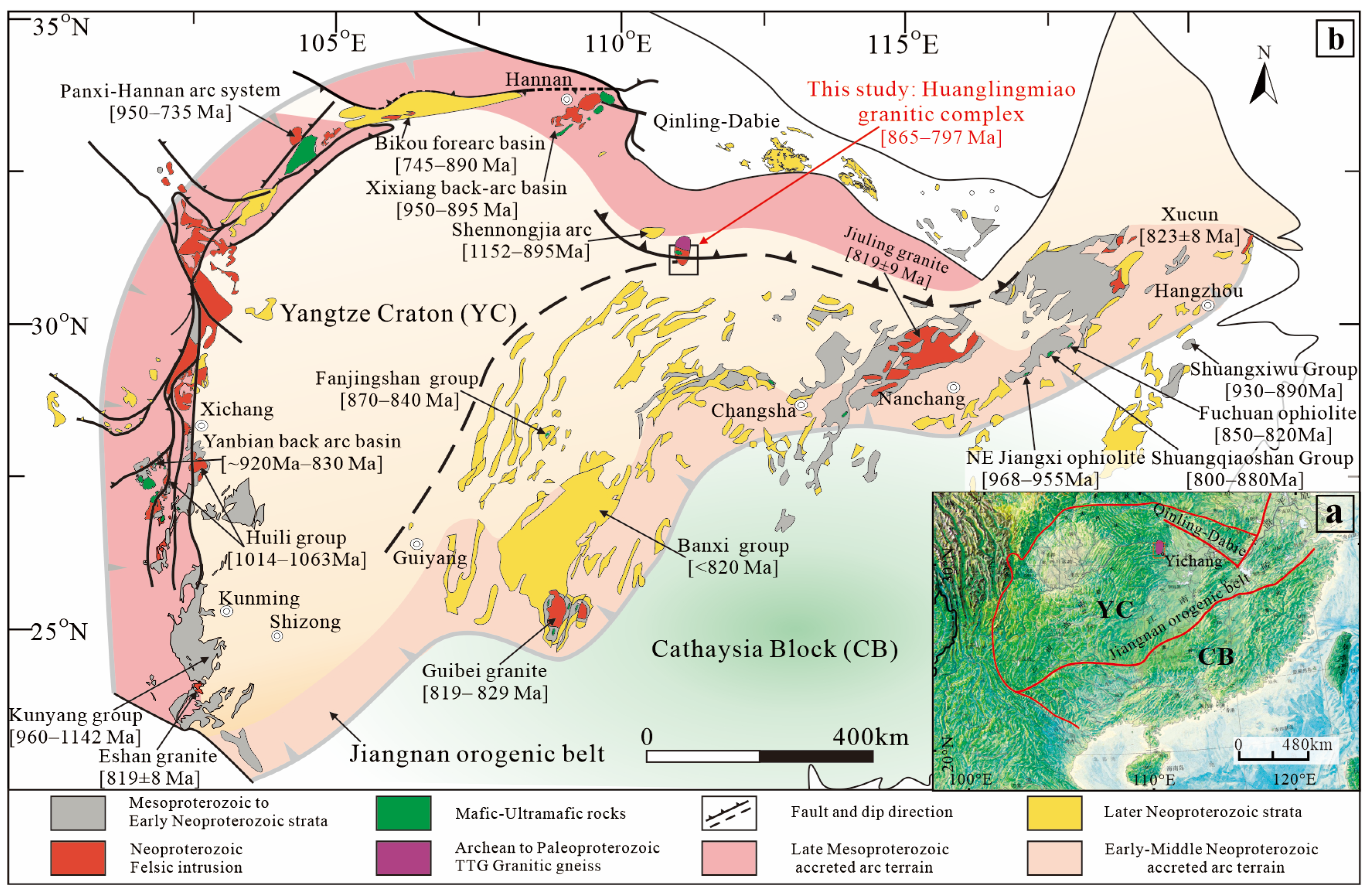

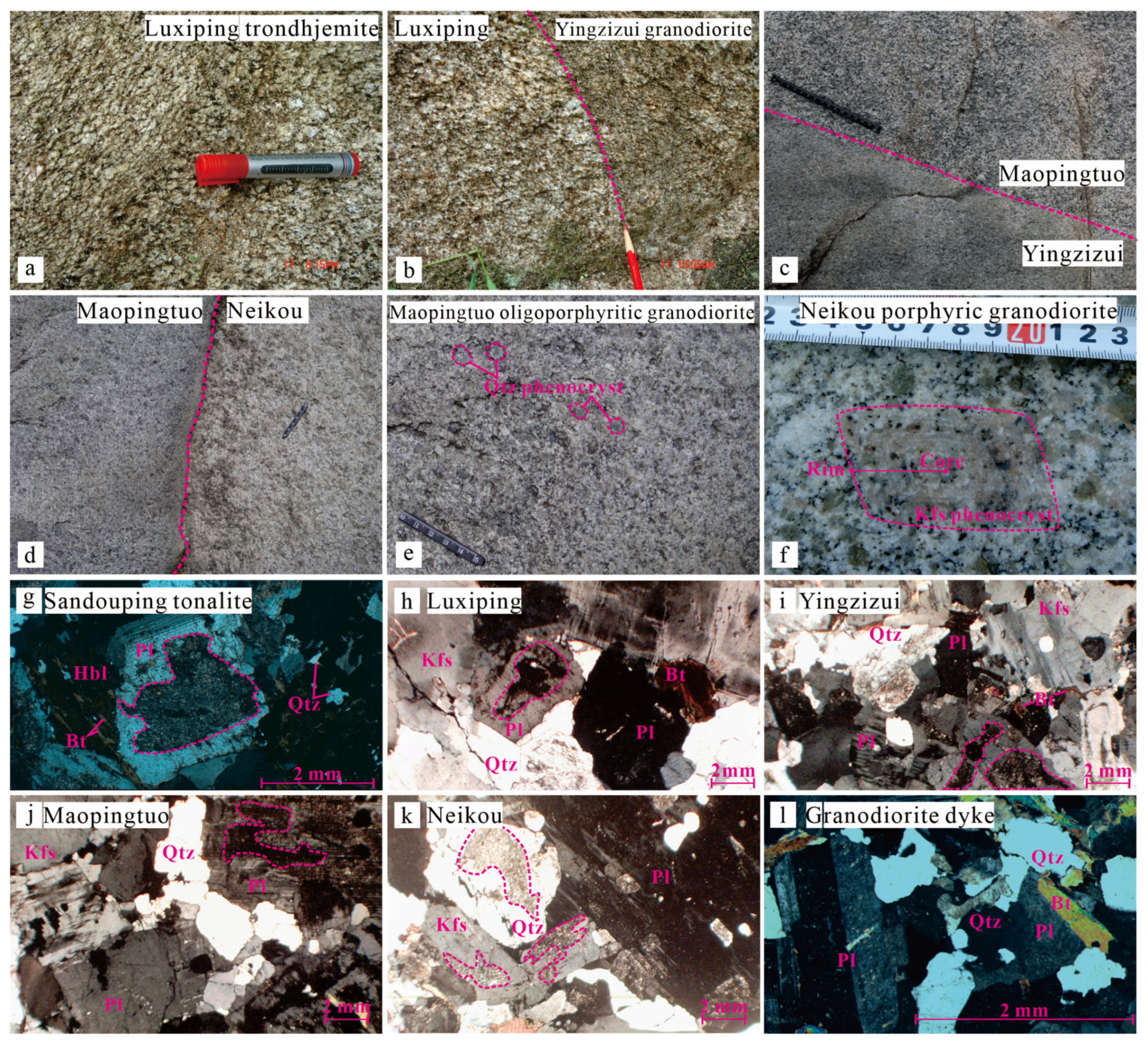
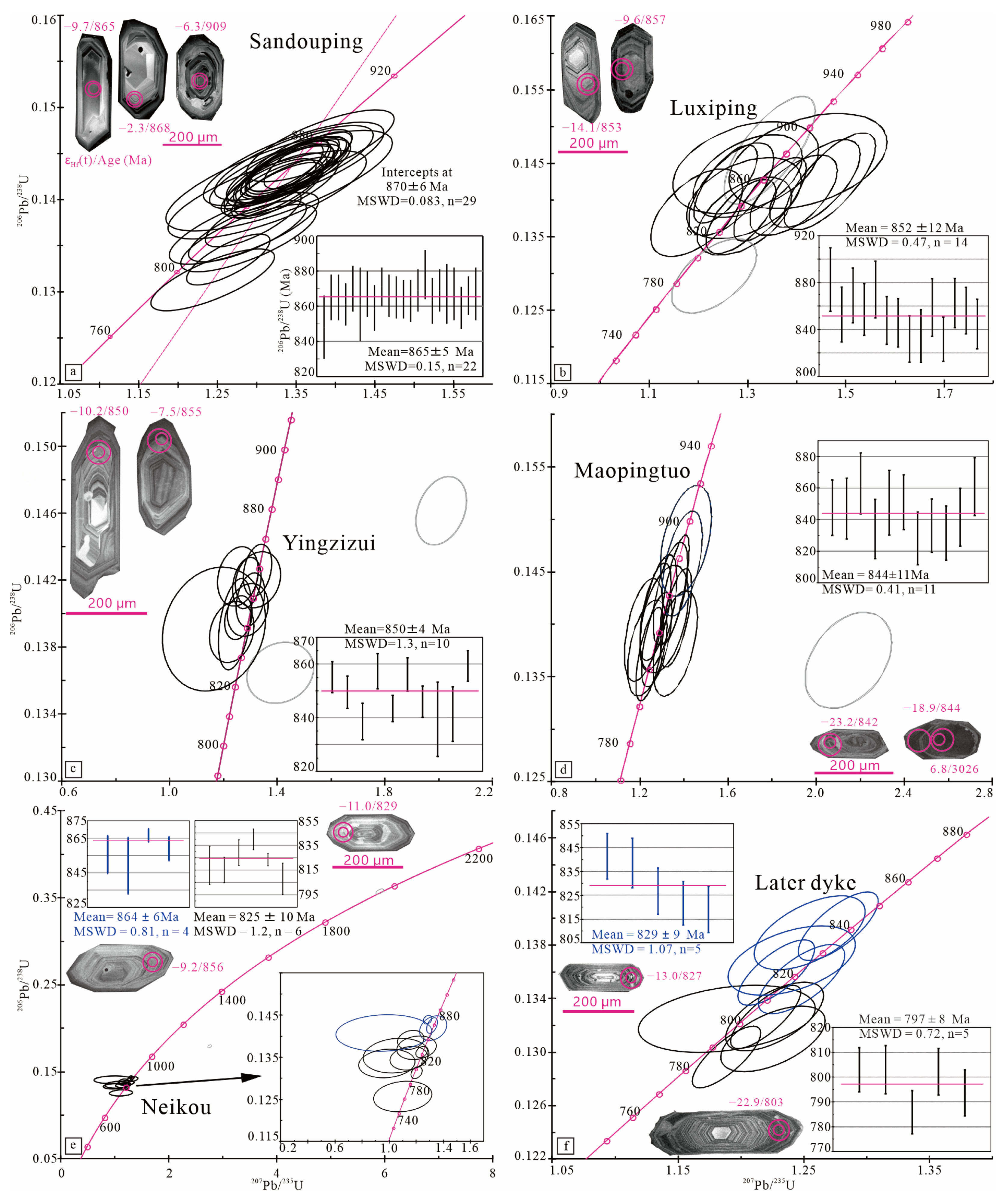
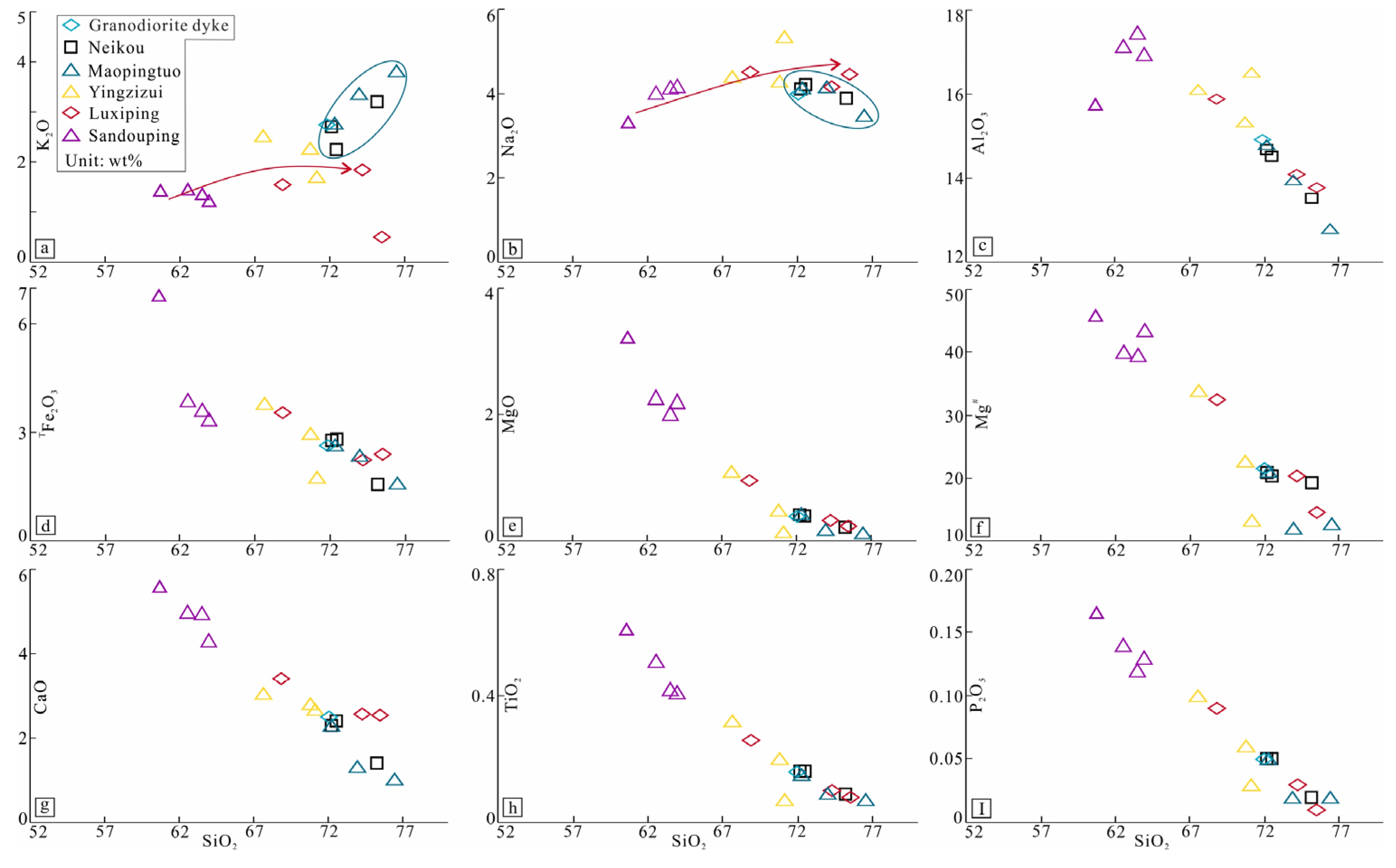

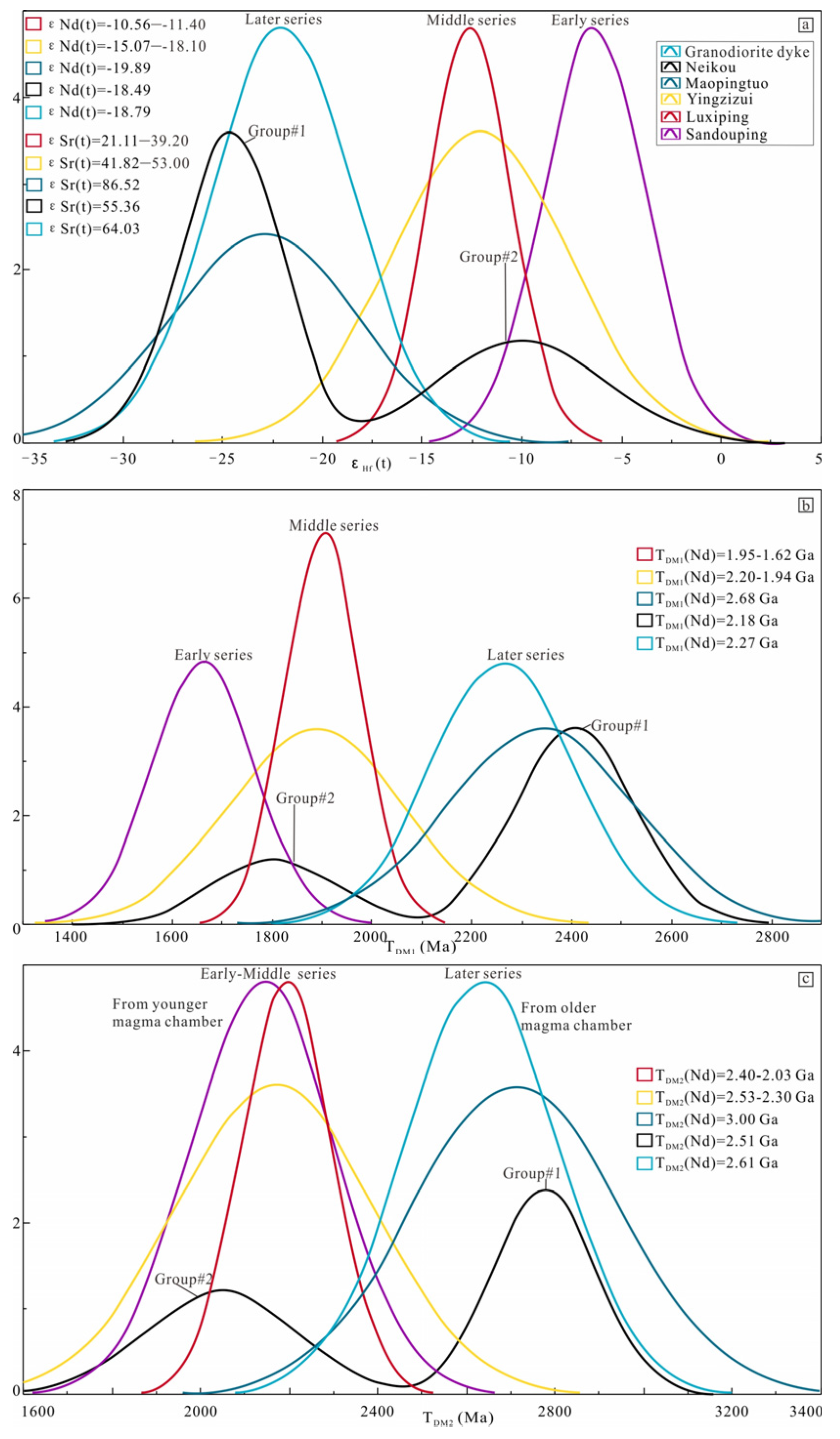

Disclaimer/Publisher’s Note: The statements, opinions and data contained in all publications are solely those of the individual author(s) and contributor(s) and not of MDPI and/or the editor(s). MDPI and/or the editor(s) disclaim responsibility for any injury to people or property resulting from any ideas, methods, instructions or products referred to in the content. |
© 2024 by the authors. Licensee MDPI, Basel, Switzerland. This article is an open access article distributed under the terms and conditions of the Creative Commons Attribution (CC BY) license (https://creativecommons.org/licenses/by/4.0/).
Share and Cite
Wei, Y.; Li, H.; Zhou, W.; Ma, C.; Chi Fru, E.; Xu, D.; Deng, X.; Tan, M.; Zhao, X.; Xu, Y.; et al. The Early Neoproterozoic Andean-Type Orogenic and Within-Plate Magmatic Events in the Northern Margin of the Yangtze Craton during the Convergence of the Rodinia Supercontinent. Minerals 2024, 14, 820. https://doi.org/10.3390/min14080820
Wei Y, Li H, Zhou W, Ma C, Chi Fru E, Xu D, Deng X, Tan M, Zhao X, Xu Y, et al. The Early Neoproterozoic Andean-Type Orogenic and Within-Plate Magmatic Events in the Northern Margin of the Yangtze Craton during the Convergence of the Rodinia Supercontinent. Minerals. 2024; 14(8):820. https://doi.org/10.3390/min14080820
Chicago/Turabian StyleWei, Yunxu, Haiquan Li, Wenxiao Zhou, Changqian Ma, Ernest Chi Fru, Daliang Xu, Xin Deng, Mantang Tan, Xiaoming Zhao, Yang Xu, and et al. 2024. "The Early Neoproterozoic Andean-Type Orogenic and Within-Plate Magmatic Events in the Northern Margin of the Yangtze Craton during the Convergence of the Rodinia Supercontinent" Minerals 14, no. 8: 820. https://doi.org/10.3390/min14080820
APA StyleWei, Y., Li, H., Zhou, W., Ma, C., Chi Fru, E., Xu, D., Deng, X., Tan, M., Zhao, X., Xu, Y., & Liu, H. (2024). The Early Neoproterozoic Andean-Type Orogenic and Within-Plate Magmatic Events in the Northern Margin of the Yangtze Craton during the Convergence of the Rodinia Supercontinent. Minerals, 14(8), 820. https://doi.org/10.3390/min14080820







